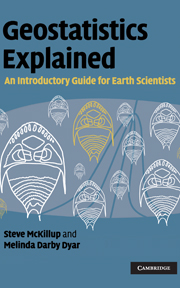Book contents
- Frontmatter
- Contents
- Preface
- 1 Introduction
- 2 “Doing science”: hypotheses, experiments and disproof
- 3 Collecting and displaying data
- 4 Introductory concepts of experimental design
- 5 Doing science responsibly and ethically
- 6 Probability helps you make a decision about your results
- 7 Working from samples: data, populations and statistics
- 8 Normal distributions: tests for comparing the means of one and two samples
- 9 Type 1 and Type 2 error, power and sample size
- 10 Single-factor analysis of variance
- 11 Multiple comparisons after ANOVA
- 12 Two-factor analysis of variance
- 13 Important assumptions of analysis of variance, transformations and a test for equality of variances
- 14 Two-factor analysis of variance without replication, and nested analysis of variance
- 15 Relationships between variables: linear correlation and linear regression
- 16 Linear regression
- 17 Non-parametric statistics
- 18 Non-parametric tests for nominal scale data
- 19 Non-parametric tests for ratio, interval or ordinal scale data
- 20 Introductory concepts of multivariate analysis
- 21 Introductory concepts of sequence analysis
- 22 Introductory concepts of spatial analysis
- 23 Choosing a test
- Appendices
- References
- Index
19 - Non-parametric tests for ratio, interval or ordinal scale data
Published online by Cambridge University Press: 05 June 2012
- Frontmatter
- Contents
- Preface
- 1 Introduction
- 2 “Doing science”: hypotheses, experiments and disproof
- 3 Collecting and displaying data
- 4 Introductory concepts of experimental design
- 5 Doing science responsibly and ethically
- 6 Probability helps you make a decision about your results
- 7 Working from samples: data, populations and statistics
- 8 Normal distributions: tests for comparing the means of one and two samples
- 9 Type 1 and Type 2 error, power and sample size
- 10 Single-factor analysis of variance
- 11 Multiple comparisons after ANOVA
- 12 Two-factor analysis of variance
- 13 Important assumptions of analysis of variance, transformations and a test for equality of variances
- 14 Two-factor analysis of variance without replication, and nested analysis of variance
- 15 Relationships between variables: linear correlation and linear regression
- 16 Linear regression
- 17 Non-parametric statistics
- 18 Non-parametric tests for nominal scale data
- 19 Non-parametric tests for ratio, interval or ordinal scale data
- 20 Introductory concepts of multivariate analysis
- 21 Introductory concepts of sequence analysis
- 22 Introductory concepts of spatial analysis
- 23 Choosing a test
- Appendices
- References
- Index
Summary
Introduction
This chapter describes some non-parametric tests for ratio, interval and ordinal scale univariate data. These tests do not use the predictable distribution of sample means, which is the basis of most parametric tests, to infer whether samples are from the same population. Consequently non-parametric tests are generally not as powerful as their parametric equivalents, but if the data are grossly non-normal and cannot be satisfactorily improved by transformation, it is necessary to use one of these tests.
Non-parametric tests are often called “distribution free tests” but most nevertheless assume that the samples being analyzed are from populations with the same distribution. Therefore, most non-parametric tests should not be used where there are gross differences in distribution (including the variance) among samples. The general rule that the ratio of the largest to smallest sample variance should not exceed 4 : 1 discussed in Chapter 13 also applies to non-parametric tests.
Many non-parametric tests for ratio, interval or ordinal data calculate a statistic from a comparison of two or more samples and work in the following way.
First, the raw data are converted to ranks. For example, the lowest value is assigned the rank of “1”, the next highest “2” etc. This transforms the data to an ordinal scale (see Chapter 3) with the ranks indicating only their relative order. Under the null hypothesis that the samples are from the same population you would expect a similar range of ranks within each, with differences among samples occurring only by chance.
- Type
- Chapter
- Information
- Geostatistics ExplainedAn Introductory Guide for Earth Scientists, pp. 247 - 269Publisher: Cambridge University PressPrint publication year: 2010

